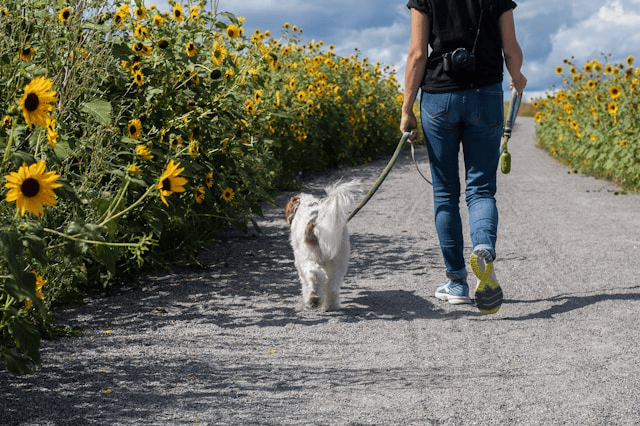Walking your dog is one of the most essential parts of responsible pet ownership. It goes far beyond just helping your dog “do their business” daily dog walks play a key role in your dog’s physical health, mental well-being, and overall happiness. But how often should you walk your dog, and for how long?
There’s no one-size-fits-all answer. Just like humans, dogs have different needs depending on their breed, age, health, and energy levels. In this guide, we’ll break down everything you need to know to create the best dog walking schedule for your furry friend.
Why Walking Your Dog Matters
Before we get into how often you should walk your dog, it’s important to understand why it’s so crucial.
Regular walks offer:
-
Physical exercise: Prevents obesity and supports muscle tone and cardiovascular health.
-
Mental stimulation: New smells, sounds, and sights keep your dog’s mind sharp and curious.
-
Behavioral benefits: Dogs who get regular walks tend to be calmer, less anxious, and less likely to display destructive behavior at home.
-
Socialization: Encounters with other dogs and people help your dog become more confident and well-adjusted.
In short, a consistent walking routine improves your dog’s quality of life and yours, too.
Factors That Influence How Often You Should Walk Your Dog
1. Breed and Energy Level
Some breeds need significantly more exercise than others. For example:
-
High-energy breeds like Border Collies, Huskies, and Belgian Malinois may require 1.5–2 hours of walking (or more) per day.
-
Moderate-energy breeds like Labradors, Cocker Spaniels, and Boxers often need about an hour a day.
-
Low-energy breeds such as Bulldogs, Pugs, or Shih Tzus may be content with 20–30 minutes of daily activity.
Understanding your dog’s energy needs helps you tailor a dog walking schedule that suits them best.
2. Age
-
Puppies: Short, frequent walks are ideal. Their joints are still developing, so avoid long distances. A few 5–10 minute walks a day is a good start.
-
Adult dogs: Most healthy adults benefit from at least 30 minutes to 2 hours of physical activity daily, which can be broken into 1–3 walks.
-
Senior dogs: Walks are still important but should be shorter and gentler. Pay attention to their pace and adjust accordingly.
3. Health and Mobility
If your dog has medical issues like arthritis, obesity, or heart problems, consult your vet. While some dogs need gentle exercise to stay mobile, others may require rest or special care.
How Long Should You Walk Your Dog Each Day?
As a general rule:
-
Small/toy breeds: 20–30 minutes daily may suffice
-
Medium breeds: 45 minutes to 1 hour
-
Large and active breeds: 1 to 2 hours
You can divide walks into multiple sessions. For example, two 30-minute walks are often better than one hour-long walk, especially for young or older dogs.
Pay attention to your dog’s behavior. If they seem restless, anxious, or hyper, they may need more exercise. If they lag behind or seem sore, you may be overdoing it.
Can a Backyard Replace Walks?
No, even if your dog has access to a big yard, it doesn’t replace the need for daily dog walks. Running in the backyard doesn’t offer the same mental stimulation or environmental variety. Walks provide exploration, bonding time, and a structured outlet for energy.
Tips for Building a Healthy Dog Walking Schedule
-
Consistency is key: Dogs thrive on routine. Try to walk at the same times each day.
-
Adjust to the weather: Avoid walking during extreme heat or cold. In hot weather, walk early or late. In winter, use booties or coats if needed.
-
Choose the right gear: A comfortable leash and harness make all the difference. Retractable leashes aren’t ideal for training or high-traffic areas.
-
Bring essentials: Water, poop bags, treats, and maybe a toy can be useful, especially on longer walks.
-
Mix up your routes: Changing scenery provides new stimulation and keeps walks interesting for your dog.
Common Mistakes to Avoid
-
Overwalking young puppies: Their joints are fragile. Stick to short, frequent walks and build up gradually.
-
Skipping walks due to bad weather: Try indoor play, puzzle toys, or a quick walk under shelter. Dogs still need activity, rain or shine.
-
Using walks only for potty breaks: Dogs need longer walks for enrichment. Potty-only outings aren’t enough.
FAQs About Walking Your Dog
Is once a day enough?
For some dogs, yes especially seniors or low-energy breeds. But many dogs benefit from two or more shorter walks a day, providing more consistent exercise and stimulation.
Are short walks okay for small dogs?
Absolutely. Small dogs often tire out faster, so multiple short walks work well. Just ensure they’re getting enough time to sniff and explore.
What if I don’t have time to walk my dog every day?
If your schedule is tight, consider hiring a dog walker, using doggy daycare, or setting up indoor enrichment. Regular walks are still essential, but there are creative ways to meet your dog’s needs.
Conclusion:
Ultimately, how often you should walk your dog depends on their individual needs. A young Labrador and an elderly Pomeranian won’t thrive on the same schedule. The key is to observe your dog’s behavior, energy, and mood, and adjust accordingly.









